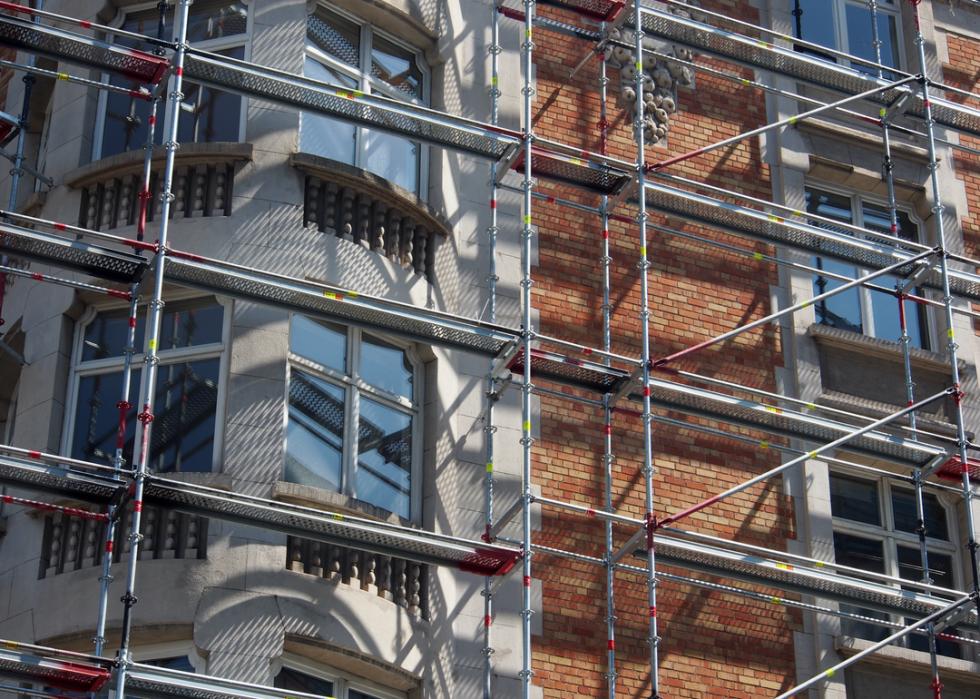
This story originally appeared on ZeroDown and was produced and distributed in partnership with Stacker Studio.
Real estate trends to follow in 2022
To say that the real estate market has shifted and evolved throughout the past year would be a slight understatement. Over the past 365 days, home prices have skyrocketed. Owners’ home values have climbed further and further upward. Competition for housing has been extremely stiff. Investors are snatching up properties in every market—large and small. Buyers who would normally be able to secure homes are being priced out left and right.
As 2021 comes to a close, the pandemic-fueled home-buying uptick continues. Homes are still selling for well over asking price in most markets, despite being in the historically slow season for real estate. Buyers are still struggling to find houses in most markets. Cash buying dominates. Most markets are still facing extremely low levels of housing inventory. And, home values are still skyrocketing for the lucky homeowners who have managed to secure properties.
With so many unusual trends occurring in the housing market, it begs the question of what will happen with real estate in 2022. Will markets continue to be on fire? Will the pandemic continue to fuel low interest rates? Perhaps most importantly, what can you expect next year’s dominating real estate trends to be—and why?
To help answer these burning real estate questions, rent-to-own platform ZeroDown compiled a list of 10 real estate trends to follow in 2022, using information from real estate agents, forecast models, brokers, and other real estate experts. Here’s what that information showed about next year’s real estate trends.

Industrial properties continue to be in high demand
E-commerce had already become extremely popular with consumers before the coronavirus, thanks to the widespread popularity of retailers like Amazon and other online outlets. The shift from in-person shopping to online shopping that has occurred over the past two years has helped e-commerce grow at a rapid pace. In turn, there has been a huge uptick in demand for industrial properties, like warehouses, to store all of the items these retailers are selling. After all, there has to be somewhere local to store the inventory, otherwise shipping would take forever—and e-commerce retailers bank on perks like quick shipping to set them apart. The demand for more warehouse and industrial space by e-commerce businesses is almost certainly going to continue into 2022—and beyond, which will lead to more investors and businesses snapping up these spaces.

Climate issues may impact some markets
Wildfires well after fire season, tornadoes in December, and other unusual weather events have dominated the news cycles in 2021—and there’s a good chance that these abnormal weather and natural disaster patterns will continue to plague the nation in 2022. As such, it’s likely these issues will also have a big impact on the price and desirability—or even the ability to finance home purchases—in certain areas. For example, beachfront communities have traditionally commanded a premium from buyers, but in many areas, rising temperatures have caused these homes to be at risk of hurricanes and flooding. That type of risk could make homes in these markets a tough sell for buyers—and for lenders—which would drive down home prices. This has already happened in certain parts of the nation, and it’s likely to continue, despite the hot national market.

Revitalization efforts shift into high gear
There has been a significant shift in population growth from large metro areas to secondary markets—and it could have a significant impact on revitalization efforts in 2022. These smaller markets weren’t prepared for the influx of new residents, and in many areas, real estate remains scarce. As such, it’s likely that revitalization efforts in secondary markets will kick into high gear next year to accommodate the new residents. What this means is that many neighborhoods in these secondary markets will become a gold mine for developers and investors. Older homes will be gutted or torn down to make way for new construction, and affordable neighborhoods in prime locations will become high-dollar havens for new residents. This will also change the face of communities and commercial districts in secondary markets across the nation—which may be a good thing or a not-so-good thing, depending on which side of the fence you sit.

Rent prices continue the upward trajectory
Rent prices have been rapidly increasing since the start of the pandemic, and that’s likely to continue into 2022. There simply aren’t enough rental units available to meet demand in most areas, and with more demand than supply, rent increases are all but guaranteed. As of November 2021, national multifamily rent growth was up 13.5% year-over-year. Builders are working in most markets to help meet the need, but the rental units aren’t going up fast enough to meet the surge in rental demand. And, other issues, like a high cost of construction materials and rampant supply chain issues, have made it tough for builders to pick up the pace. In turn, rent prices are likely to continue to climb—and may even surpass home value growth. What this means for landlords is bigger payouts, but for many renters, it means a lot more money going toward rent—and a lot less left over for other expenses.

Mortgage rates may increase
Over the past year, mortgage rates have stayed extremely low, but that will likely change in 2022. Most experts agree there will be at least a marginal increase in interest rates by the Federal Reserve next year, which means that borrowing will get more expensive across the board. It’s impossible to predict how high they will go, but some experts expect the rates to increase to either the high 3% to low 4% range. That may not seem like a huge increase, but even a marginal rate increase can tack on a huge amount in interest to your mortgage loan. This may make it tough for lower- to moderate-income buyers to afford a home purchase—especially when you calculate the continuing higher home prices.

Home value appreciation could slow down
Homes appreciated at rapid rates throughout 2021—in large part because the market has been so hot across the nation. That is likely to change next year, though, as that rapid appreciation rate is expected to slow down, at least somewhat. Appreciation rates were at nearly 20% in mid-2021, and Fannie Mae expects a 7.9% home appreciation rate for 2022, and Freddie Mac predicts a similar appreciation rate of about 7%. Other housing authorities are split on the rate, but nearly all agree the appreciation rate will be lower than it was in 2021. What this means for buyers is that the homes they purchase may not skyrocket in value as quickly as they would have in 2021—but it’s unlikely there will be mass depreciation, either. Home values will still grow, but it will be at a slightly more manageable pace, which could make it easier for buyers with smaller budgets to compete.

Cash deals continue to dominate
Cash deals have taken over in 2021, with investors large and small offering to pay cold, hard cash for homes. That investment trend is likely to continue into 2022, as it doesn’t appear that the push for more property investments is slowing down, despite the rapidly increasing real estate prices. What this means for some real estate professionals is they could be boxed out of the equation. Unlike regular home buyers with mortgage loans, cash buyers don’t need to meet financing requirements, like inspections, appraisals, or other home-related services, to complete the deal. This cash purchase trend will also continue to make the market extremely competitive for regular buyers, who have a tough time competing with cash offers.

Home auction sites grow in popularity
Over the past year, there has been an incredible amount of competition for limited housing inventory—and that isn’t expected to slow down next year. As such, it’s highly likely that home listings on alternative selling platforms, like auction sites, will become more common. Listing homes for auction will allow sellers to reap the full benefits of the competitive market—and will also expedite the buying process. A boom in home auctions will also benefit investors, who can make offers on properties in any market from anywhere in the world. This will further cut down on the costs for investors, who typically need to be present for traditional real estate deals. The only parties it likely won’t benefit are regular buyers, who will have to contend with bigger pools of buyers on auction sites—and even lower volumes of regular home inventory as listings shift to alternative platforms like these.

Housing inventory remains low
Thanks to the surge in buyers during the pandemic, both existing and new home inventory has been extremely low throughout 2021, and it’s likely to stay that way throughout 2022. One of the main catalysts for the low inventory is that homeowners have been hesitant to list their homes for sale, as there is no guarantee they will be able to find an affordable home to purchase—or a rental to lease. New home construction isn’t keeping up with the surge in demand, either. There have been huge issues with the supply chain, which have made construction materials more expensive and hard to come by. That isn’t likely to change next year, as supply chain issues are still ongoing, and the rapidly increasing home prices make it even less likely that current owners will sell their homes and add more inventory to the market.

Commercial real estate investing goes mainstream
Interest in real estate investing has exploded over the past few years, but these opportunities have largely been limited to specialized investors or investors with deep pockets who could afford to dump huge amounts of money into projects. That playing field could become more level in 2022 since commercial real estate investing is poised to become more mainstream next year. Large trading platforms that once specialized in making the stock market accessible to the everyday investor have now set their sights on the real estate market. As more of these platforms begin to offer up trade shares of individual real estate assets, it will get a lot easier—and require a lot less cash—to invest. With that, a market that was once limited to certain pools of investors will be accessible to anyone who wants to pony up the cash to buy a few shares of a real estate asset.



